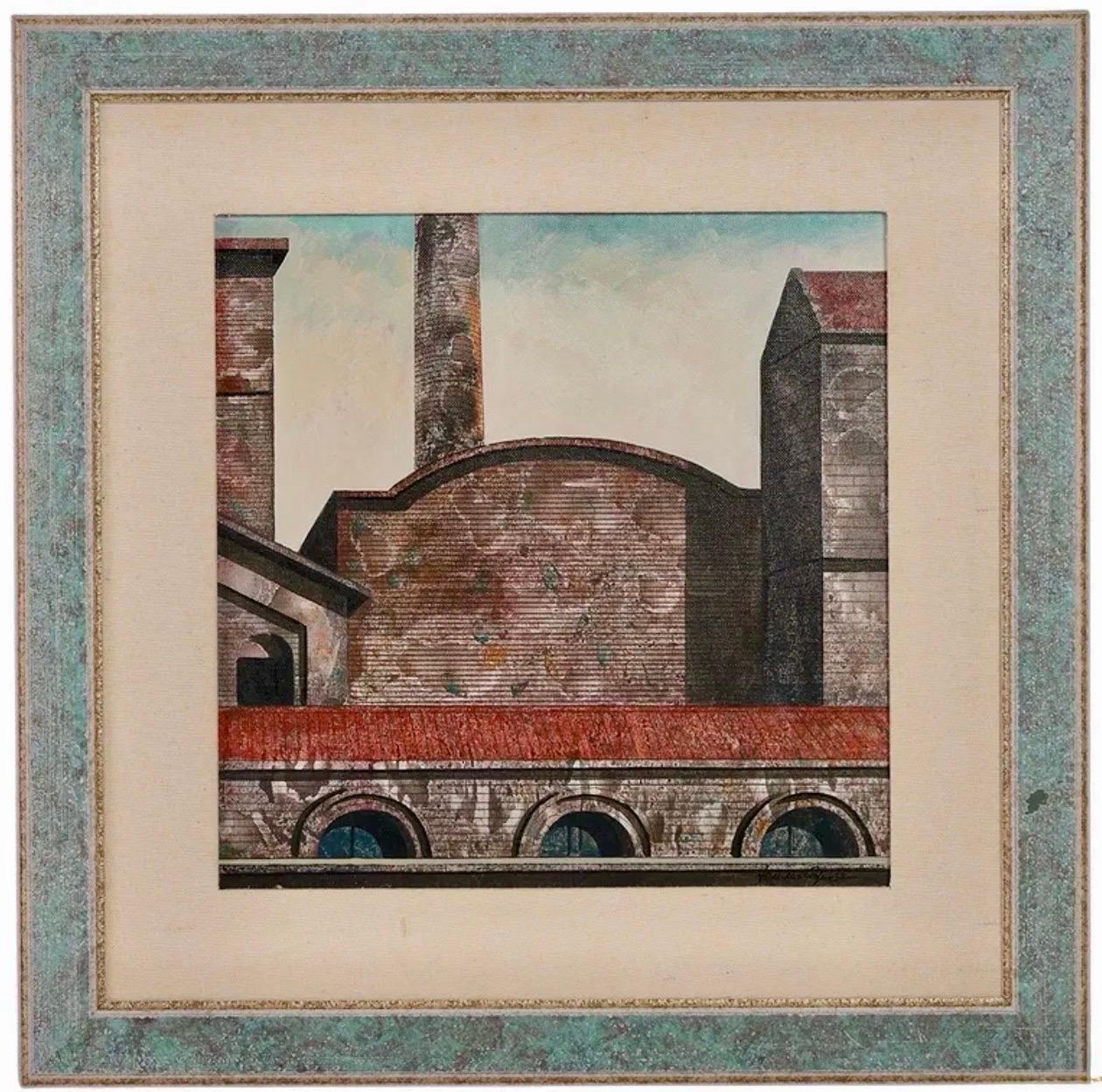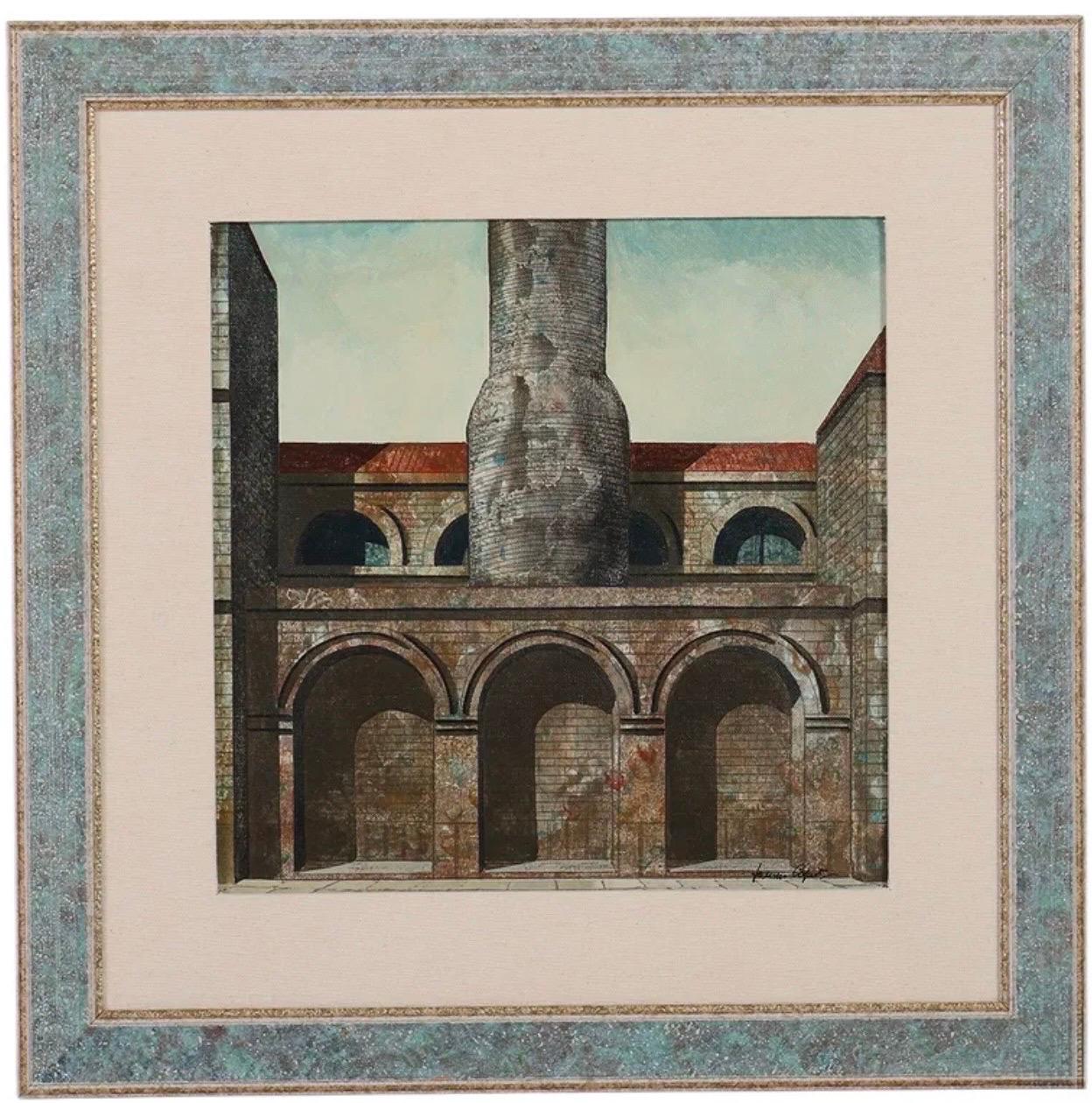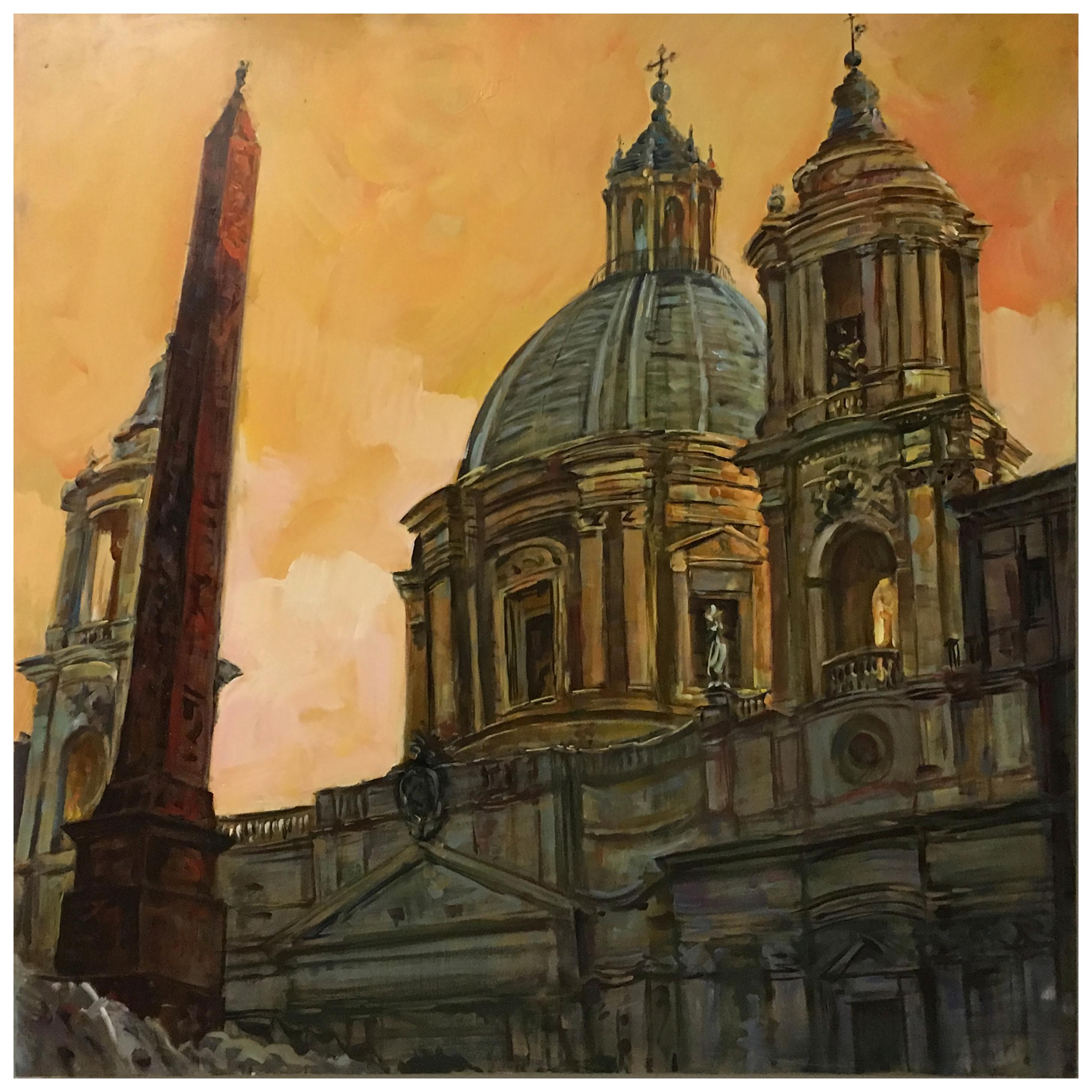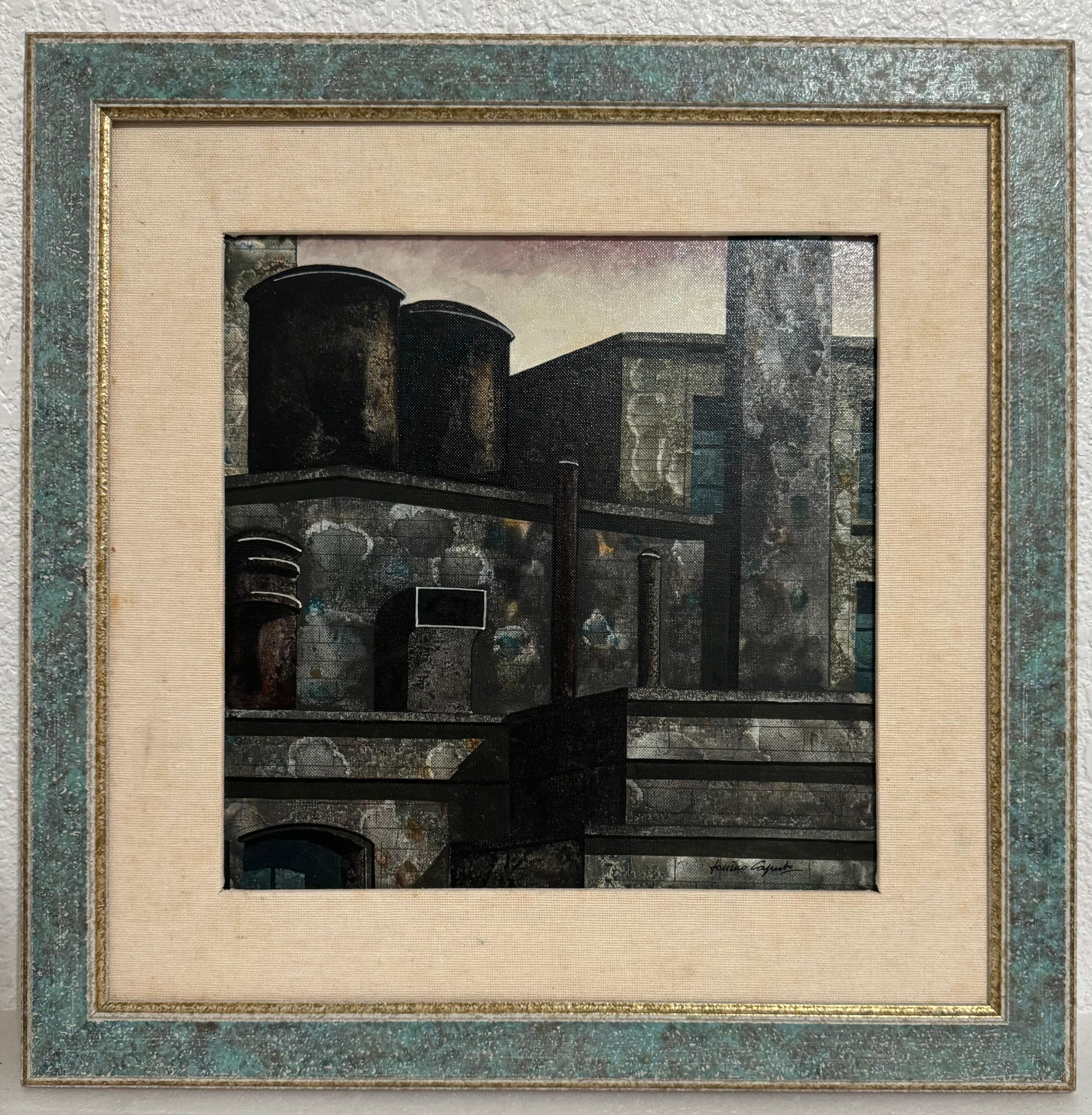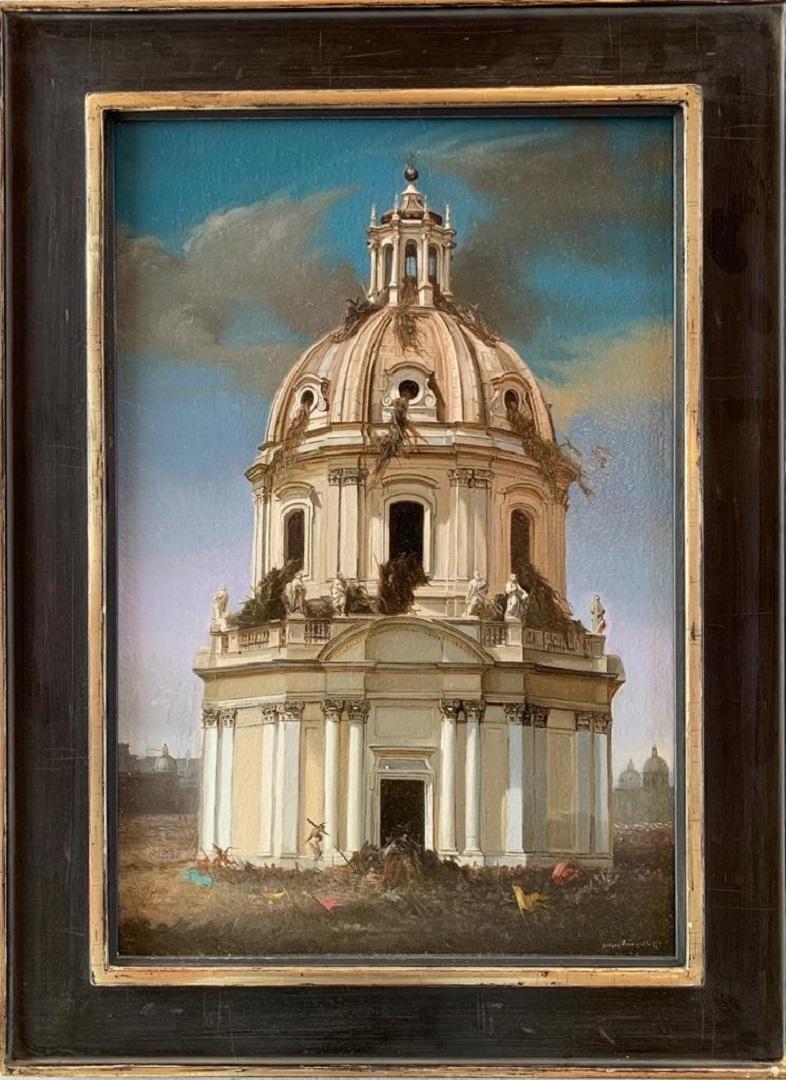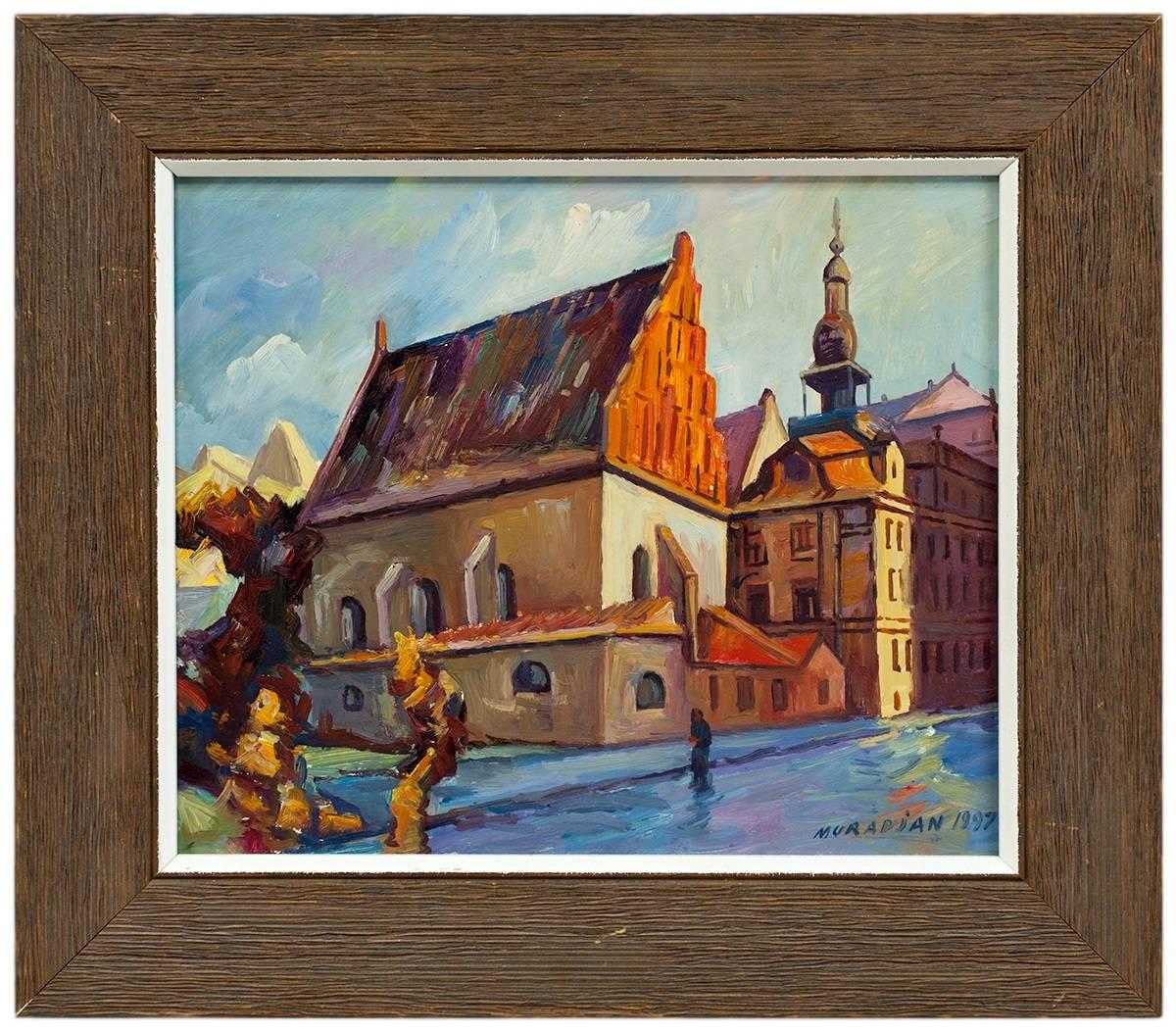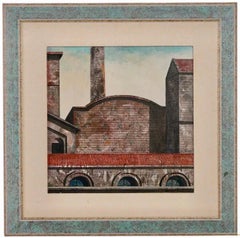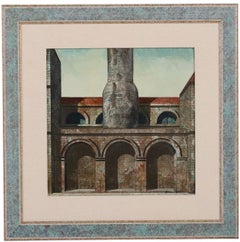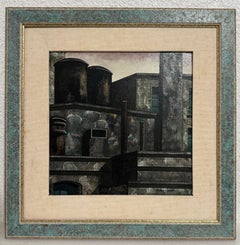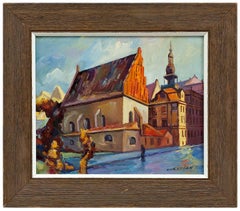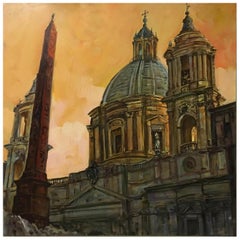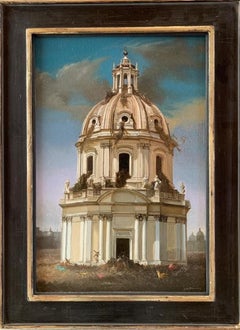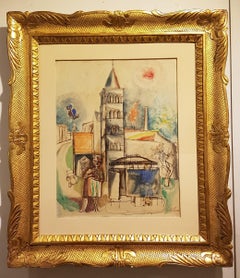Items Similar to Large Oil Painting Italian Synagogue Rome Antonio Caputo Architecture Judaica
Want more images or videos?
Request additional images or videos from the seller
1 of 17
Tonino CaputoLarge Oil Painting Italian Synagogue Rome Antonio Caputo Architecture Judaica
$5,500
£4,264.54
€4,836.61
CA$7,884.01
A$8,574.04
CHF 4,517
MX$104,133.38
NOK 56,787.79
SEK 53,233.96
DKK 36,311.85
About the Item
Antonio Caputo (Italian, 1933-2021)
Tempio Maggiore (The Bridge)
Hand signed lower right, 'Tonino Caputo'
Oil on canvas depicting the Great Synagogue of Rome with its distinctive dome and ornate façade rising behind the Tiber River. The composition is framed by tree-lined surroundings beneath a clear blue sky. Hand-titled on verso "Rome ‘Sinagoge'" with artist signature.
This is not famed. it is mounted on a wood stretcher.
Dimensions: 31.5 X 35.5 X 1 in.
Born in Lecce, 1933, Antonio Caputo studied in Rome at the Faculty of Architecture and held his first exhibition in 1956. He first engaged with art as a teenager. In 1952 he embarked on a trip around the world. He was a friend of Piero Manzoni, who consecrated him "living sculpture number 3", he worked in the graphic design of posters, book covers and screenplays. His architectural views of Venice and Rome as well as New York City are well known in particular graffiti scenes and urban architecture. In 1956 he participated in his first collective exhibition in Rome, where he exhibited figurative drawings. During the same year, he met Gastone Novelli and began to explore the field of informal art, an artistic journey that lasted five years. In 1958, he participated in a collective painting exhibition in Rome together with renowned artists such as Mimmo Rotella, Carla Accardi, Cy Twombly, Corrado Cagli, Giandomenico Gnoli and Gastone Novelli. From 1963-1965, he painted and studied in Paris, France and, in 1965, exhibited at Rome's IX Quadrennial. In 1966, Caputo started working as a set designer with the theater and cinema of the Italian director, Carmelo Bene, with whom he became close friends and collaborated with for many years. He designed the sets for Nostra Signora dei Turchi and Capricci and all the posters for Bene's theatrical shows of this period. In 1972, he participated in the Venice Biennale (Theatre section) with the sets for the drama "Ecloga" by Franco Cuomo and Marica Boggio. Between 1983 and 1984, he executed two altarpieces for the church of Quercia di Aulla (Massa-Carrara). Since 1982, Tonino has opened a studio in New York and has lived in Manhattan for part of the year. During the 1980s, he participated in several traveling graphics exhibitions organized by the Rome Art Quadrennial in collaboration with the Ministry of Foreign Affairs. In 1992, the English magazine "Art & Design" recognized Tonino Caputo as one of the 50 most important Italian artists of the second half of the twentieth century. Towards the end of the 1990s, he created two lithographs commissioned by the mayor of Helsingborg and a mosaic installed in Bracciano station.Caputo traveled widely including to Eastern Europe (1970-1973), Australia (1977-1979), Sweden (1983) and, from 1984, between New York and Rome. Over the course of a long career, Caputo exhibited widely and successfully and was the recipient of numerous prizes, medals and juried awards. In 1992, Caputo was listed among the fifty most significant Italian artists of the second half of the 20th century by the English magazine Art and Design. The artist's works are held in prominent private and public collections including the permanent collections of works appear in private and public collections including the permanent collections of the Avellino Art Museum and the Iowa State Museum at Des Moines, among others.
The Great Synagogue of Rome (Italian: Tempio Maggiore di Roma) is an Orthodox Jewish congregation and synagogue, that is located at Lungotevere de' Cenci, in Rome, in Lazio, Italy. Designed by Vincenzo Costa and Osvaldo Armanni in an eclectic mix of Historicism and Art Nouveau styles, the synagogue was completed in 1904. It is the largest synagogue in Rome. The present synagogue was constructed shortly after the unification of Italy in 1870, The Roman Ghetto was demolished and the Jews were granted citizenship. In addition to serving as a house of judaic worship, it is also serves a cultural and organizational centre for la Comunità Ebraica di Roma (the Hebrew community of Rome). It houses the offices of the Chief Rabbi of Rome, as well as the Jewish Museum of Rome. Designed by Vincenzo Costa and Osvaldo Armanni, the synagogue was built from 1901 to 1904 on the banks of the Tiber, overlooking the former ghetto. It contains elements of Assyrian-Babylonian, Egyptian and Greco-Roman architecture. The eclectic style of the building makes it stand out, even in a city known for notable buildings and structures. The aluminium dome is the only square dome in the city and makes the building easily identifiable, even from a distance. The interior of the synagogue is lavishly decorated in the Art Nouveau style.
- Creator:Tonino Caputo (1933 - 2021, Italian)
- Dimensions:Height: 31.5 in (80.01 cm)Width: 35.5 in (90.17 cm)
- Medium:
- Movement & Style:
- Period:
- Condition:
- Gallery Location:Surfside, FL
- Reference Number:1stDibs: LU38216369912
About the Seller
4.9
Platinum Seller
Premium sellers with a 4.7+ rating and 24-hour response times
Established in 1995
1stDibs seller since 2014
1,824 sales on 1stDibs
Typical response time: 1 hour
- ShippingRetrieving quote...Shipping from: Surfside, FL
- Return Policy
Authenticity Guarantee
In the unlikely event there’s an issue with an item’s authenticity, contact us within 1 year for a full refund. DetailsMoney-Back Guarantee
If your item is not as described, is damaged in transit, or does not arrive, contact us within 7 days for a full refund. Details24-Hour Cancellation
You have a 24-hour grace period in which to reconsider your purchase, with no questions asked.Vetted Professional Sellers
Our world-class sellers must adhere to strict standards for service and quality, maintaining the integrity of our listings.Price-Match Guarantee
If you find that a seller listed the same item for a lower price elsewhere, we’ll match it.Trusted Global Delivery
Our best-in-class carrier network provides specialized shipping options worldwide, including custom delivery.More From This Seller
View AllOil Painting Italian Cityscape Rome Architecture Tonino Antonio Caputo
Located in Surfside, FL
Antonio Caputo (Italian, 1933-2021)
Architectural oil paintings on canvas boards titled Testaccio. The composition captures a distinct stark Italian cityscape, blending classical a...
Category
20th Century Post-Modern Landscape Paintings
Materials
Canvas, Oil
Oil Painting Italian Cityscape Rome Architecture Tonino Antonio Caputo
Located in Surfside, FL
Antonio Caputo (Italian, 1933-2021)
Architectural oil paintings on canvas boards titled Fornace. The composition captures a distinct stark Italian cityscape, blending classical and i...
Category
20th Century Post-Modern Landscape Paintings
Materials
Canvas, Oil
Oil Painting Italian Cityscape Rome Architecture Tonino Antonio Caputo
Located in Surfside, FL
Antonio Caputo (Italian, 1933-2021)
Architectural oil paintings on canvas boards titled Ciney. The composition captures a distinct stark Italian cityscape, blending classical and ind...
Category
20th Century Post-Modern Landscape Paintings
Materials
Canvas, Oil
Judaica Oil Painting Altneuschul Maharal Synagogue Prague
By Hovik Muradian
Located in Surfside, FL
14.5 X 16.5 with frame
HOVIK MURADIAN
Born in 1964 in Yerevan, Armenia ,he now lives and works in Prague, Czech Republic.
His pictures are in private collections in Germany, France, America and other countries.
Hovik Muradian was born in 1964 in Yerevan, Armenia, within the view of the biblical Mt. Ararat, in the land of the sun, mountains, rocks, and savanna grass, in the country with a fate similar to that of every small country controlled by a more powerful country, in the country with the history of struggle for independence. Back in 1964, Armenia was a part of the Soviet Union and was called the Armenian Socialist Republic.
After the tragic earthquake in 1988, Hovik went on a quest for a new life outside his homeland. He found it in the Czech Republic where he has been living since 1992.
He has a nice family and a studio close to his flat in one of the Prague suburbs where he paints, and he exhibits his paintings around the world. Yet, his dark eyes keep looking through the web of nostalgia, his blood is diluted with meditation, and his romantic heart searches for angular colors of brightness. But I may be totally wrong. I am just trying to find an alibi for my headline.
Hovik Muradian was raised in a family where his father, academic painter Shavarsh Muradian (1936), whose favorite style of painting was landscape, initiated Hovik’s artistic education (the School of Arts of Jakob Kojoian, and the College of Arts of Panos Terlemezian in Yerevan from 1976 to 1984). Cultural inspiration, music, theatre, literature etc. are probably the legacy of the school; we can find symbols of the mentioned arts both in his early and later paintings. However, what the painter soon left behind was the technique of paint applying. His impasto paintings quickly changed into delicately color and delimited areas. The delimitation of shapes is a typical element in Muradian’s paintings. Sometimes, the area is geometrically divided into right-angle shapes, other times the painter seems to use different arches to make them in an abstract grouping of matter. However, he never stops there. In his compositions, we can find a part of a figure, nude, musical instrument, or common item. His genre is figurative abstraction. Rationality that forces us to meditate can be found only in his later paintings. His canvases are full of technical artifacts symbolizing time, order, as well as mystery, a pursuit to learn, search, and ask questions. His paintings clearly show what kind of questions the author asks.
Qualification:
1976 - 1980: Graduation from the School of Arts of Jacob Kojoian, Department of Paintings, Yerevan
1980 - 1984: Graduation from the Collage of Arts of P.Terlemezian, Department of Paintings, Yerevan
Single Exhibitions to Date:
1985 The House of Armenian Journalists, Yerevan (Armenia)
1994 Russian House...
Category
20th Century Expressionist Landscape Paintings
Materials
Oil
Rome (Milan) Italian Cityscape by Noted Hungarian Israeli Artist
By Claire Szilard
Located in Surfside, FL
Colorful Italian cityscape which includes elements of both Rome and Milan, noted on the back of the painting. Signed in hebrew.
Claire Szilard, a native of Hungary, is an Israeli painter and sculptor, but for the past 10 years she has again been living in Hungary. A short time after she married Pal Fusti in 1944, her sweetheart was conscripted into the work brigade, which engaged mostly in clearing mines. Like many others, Fusti never returned from the war and was declared missing.
After she gave up all hope that her husband would return, Szilard immigrated first to Switzerland and several years later, came to Israel. She lived in the artists' village of Ein Hod and later spent many years in the artists' quarter in Old Jaffa. She quickly carved out a respected place for herself among Israeli artists. She was a pioneer in the art of working in glass (vitrage). Over the years, her glasswork has decorated 14 synagogues and a number of public buildings throughout Israel. Her paintings and sculptures have been exhibited in Switzerland, Paris, Rome and London. In 1985, she was chosen painter of the year in Brazil.
Szilard lived in Israel for nearly 40 years, during which time she established a studio for herself in Paris as well, married and was widowed. After the change of regime in Hungary in 1990, she showed her works for the first time in Budapest, in the prestigious Vigado Gallery.
That particular exhibition had unexpected results. When she was in Budapest she learned by chance that her first husband had not been killed in the war, but had fallen prisoner and had returned to Hungary after a number of years. He looked for his young wife, but didn't find her. He too married and was widowed.
Forty years later, they met again. Their feelings for each other were renewed and they decided to join their lives - she at nearly 70, he at nearly 80. Pal Fusti did not feel himself in any condition to begin a new life in Israel, which was an unknown country for him, where he did not know the language and the customs. The couple thus remained in Hungary. Not too long ago, they celebrated in great style - all the "who's who" of the artistic world of the Hungarian capital was there - the 10th anniversary of their renewed meeting, her 80th birthday and his 90th.
Studies: Free Academy Budapest; School of Fine Arts, Geneva; Fresco in Ravena, Italy;
Prizes: 1969 Nordau Prize; 1984 Silver...
Category
20th Century Modern Landscape Paintings
Materials
Canvas, Oil
Outside the Synagogue Russian Judaica Oil Painting
By Emmanuel Snitkovsky
Located in Surfside, FL
This piece came from the collection of the Bezalel Art Gallery on the Lower East Side of New York City.
Emmanuil Snitkovsky is an internationally known artist, sculpture and poet.
Emmanuil Snitkovsky was born into a family of artists and scholars from the Odessa Art College in Russia. Immersed in the traditions of Russia art, he approaches form, line, space and color with relentless vision and impeccable technique.
Two highly successful artists, the husband and wife team of Emmanuil and Janet Snitkovsky have exhibited a selection of eight large Judaic paintings at the Chabad Chassidic Art Institute (Chai Gallery) in Crown Heights. Three of those paintings are truly singular visions of Jewish Art that cause us to stop and reassess our preconceptions about the meaning and importance of their subjects. Emmanuil and Janet Snitkovsky were both born in the Ukraine in the 1930′s. Emmanuil was trained in Odessa in public monument art, and Janet majored in fashion at the Lvov Decorative Art Institute. After both narrowly survived the devastation of the Second World War in Stalin’s Russia, they began to collaborate on state sponsored art works in 1962. For ten years, they worked on grandiose public sculptural projects to commemorate the fallen Russian heroes of the Second World War in Moscow, Kiev, Tula and Kazan. They were
exemplary Soviet Realists working for the Soviet regime. Eventually, this career became untenable for them, both as artists and as Jews, when they clashed with Soviet officialdom over a commission to commemorate the Babi-Yar massacre. The Soviets refused to acknowledge this massacre of 100,000 Jews and eventually suppressed the memorial. In 1978, Emmanuil and Janet arrived in New York and began to recreate their artistic lives. In the ensuing 25 years, they have been quite successful, exhibiting widely in the United States and Europe. They have nurtured a hybrid style of painting and sculpture called “Renaissance Revival” combining contemporary and classical subjects in a stylized realism that evokes both the American regionalist Thomas Hart
Benton and the Italian Renaissance master Sandro Botticelli. The works are highly proficient, polished, and commercial productions in a quirky decorative style. They have continued to accept sculptural projects that have not shied away from kitschy realistic sculptures of Charlie Chaplin as “The Kid,” The Little Tramp” and Buster Keaton as “Cameramen.” In some ways, they have appropriated American culture just as they once accepted Soviet culture.
Janet, a graduate of the Lvov College, was invited- by virtue of the high honors she
achieved there- to matriculate at the Lvov University of Art. Such an opportunity is extremely rare for anyone, particularly for someone of Jewish descent. Their works of art are included in collections of the Japanese Imperial Family...
Category
1980s Modern Landscape Paintings
Materials
Canvas, Oil, Illustration Board
You May Also Like
Church in Rome - Italian oil on canvas painting, Alfonso Pragliola
By Alfonso Pragliola
Located in Napoli, IT
CHURCH IN ROME - Italian oil on canvas painting cm.100x100, Alfonso Pragliola Italia 2010
Category
2010s Modern Landscape Paintings
Materials
Canvas, Oil
Senza Titolo Oil Painting on Canvas Rome Architecture In Stock
By Giovanni Tommasi Ferroni
Located in Utrecht, NL
Senza Titolo Oil Painting on Canvas Rome Architecture In Stock - Size Canvas 48 x 32 cm, Size with Frame 61 x 45 cm
Giovanni Tommasi Ferroni (1967, Rome) descended from an artistic ...
Category
21st Century and Contemporary Contemporary Figurative Paintings
Materials
Canvas, Oil
Price Upon Request
Free Shipping
Cathedral of S. Crisogono
By Franco Gentilini
Located in Roma, IT
Certificate of authenticity provided by the widow of the artist on photography.
Mixed media on canvas. Signed on the lower right.
Image dimensions: 47.8 x 33.7 cm
Category
1950s Modern Figurative Paintings
Materials
Mixed Media
Church Painting by Argentinian Artist Emilio Trad, Signed and Dated 1978
Located in New York, NY
Emilio Trad (Argentinian, b. 1953)
Untitled (Church), 1978
Oil on board
18 1/4 x 14 in.
Framed: 25 3/4 x 22 1/4 in.
Signed lower left: Trad
Signed and date...
Category
1970s Modern Figurative Paintings
Materials
Oil, Board
"Architectural motive 1" Original architectural landscape. Large format
Located in Oslo, NO
In this piece, I've explored the dance between light and shadow, crafting an intimate journey through an architectural passage that beckons with history and mystery. Employing oil on...
Category
2010s Post-Impressionist Landscape Paintings
Materials
Oil, Bamboo Paper
View of Celio (Rome) - Oil Paint by Pino Romanò - 1990s
Located in Roma, IT
Oil on canvas realized by Pino Romanò (1934) in 1990s.
Hand signed. Titled on rear.
Very good condition.
Category
1990s Contemporary Figurative Paintings
Materials
Canvas, Oil
More Ways To Browse
The Rabbi
Large Italian Painting
Graphic Design Poster
French Architecture House Design Lithograph
Jewish Synagogue
Italian Architecture Painting
Accardi Carla
Vintage Book Cover Posters
Oil Architecture Italian
Cy Twombly In Rome 1966
Old Barn Painting
Oregon Landscape Paintings
Painting Of Cowboys
Peconic Bay
Prairie Landscape Art
Red Sailboat
Robert Fawcett
Roman Ruins Painting
